HTPC - TV Tuner Reviews
by Jarred Walton on December 7, 2005 12:05 AM EST- Posted in
- Smartphones
- Mobile
Performance Considerations
We've talked a lot about the cards, but we haven't said much about the actual performance or CPU usage. It varies by card, as well as what content you're watching, so we captured some graphs showing CPU usage in a variety of situations. For the most part, anything faster than around 1.6 GHz P4 or 1600+ Athlon should suffice, though just to be safe, you might want closer to 2.4 GHz/2400+. Using the Sempron 64 running at 2.50 GHz was more than sufficient for everything but the MyHD analog recording. Let's start first by looking at how each card performs in analog mode. The MyHD and Theater 550 are running on the Athlon 64 4000+ HP system, while the Fusion5 is in the Sempron system. Don't worry - we're only looking for a rough estimate of CPU power requirements, and the Fusion5 worked fine with the Sempron as well as the slightly faster HP.
For watching analog content, not only is the Theater 550 a better image, but it also uses far less CPU power. In fact, the image for watching and recording with the Theater 550 is the same. Can you spot the point where we enabled recording in the graph? (The higher CPU usage at the start is actually PowerCinema loading, so don't confuse that with the latter portion of the chart.) We began recording the station on the 550 around the spot marked by the two "peaks" where CPU use spiked to 40% or so. Otherwise, CPU use remains around 10%.
The Fusion does quite well when only viewing analog channels, averaging around 20% CPU use on the Sempron system and slightly less (15%) on the 4000+ (which we didn't capture). Recording with the Fusion5 kicks CPU usage up to about 60%. That's a pretty big jump, but we were running with a maximized viewport (720p content), and we didn't experience any stalls or other problems. For watching an analog channel, the Fusion5 is a close second to the Theater 550, though it's a distant second for recording the content.
Finally, we have the MyHD card. Similar to the Fusion, watching an analog channel uses less CPU time than recording the channel. However, less in this case means about 40% CPU usage. Enabling even the fastest DivX encoding (with MP3 audio) kicks the CPU up to almost 80% usage. The video capture doesn't cut out, but there does seem to be a slight delay every second or so. Even though there is supposedly 20% idle CPU time, the capture isn't really clean, and it's about equal to watching TV with only mediocre reception. We don't have a graph, but moving to the 2.6 GHz X2 chip with Normal quality DivX encoding still used a whopping 65% of the CPU time - remember that there are two cores, so that would be over 130% CPU time for the 4000+. The faster X2 also removed the slight lag in the video, all while producing a much better encode.
Here's another version of the data, with a few additional reference points. The graphs are colored according to performance: green indicates that there were no difficulties, yellow means that there may be periodic issues, and red means that the result was unacceptable.
Moving to digital channels removes the Theater 550 from the list, but we have both the DxVA accelerated and non-DxVA modes in FusionHDTV. Most modern GPUs can use the DxVA acceleration, so consider the non-DxVA charts to be a worst case scenario. All of the results were taken while viewing a 1080i football game broadcast.
With DxVA enabled, watching 1080i with the Fusion5 requires about 20% of your CPU time. Recoding the same content appears to add about 10% more CPU use, and we get close to 30%. The non-DxVA mode requires quite a bit more power to handle the decoding of the digital signal, using 45% of the CPU power. As before, recording the same content appears to add another 10%. Remember that unlike analog signals, digital TV is already compressed. Decompressing is quite a bit easier than compressing a signal, which is why a Sempron can handle 1920x1080 video at 30 FPS without trouble, whereas the same CPU chokes when attempting to encode even 640x480 video at 30 FPS.
Viewing digital content with the MyHD is completely different from using the card in analog mode. CPU usage on the 4000+ was around 25% when viewing a 1080i signal, though disabling the overlay screen knocks that down around 15%. The record mode oddly enough has consistently lower CPU usage, at around 12 or 13%. The hardware acceleration of DTV decoding that the MyHD card provides is clearly put to good use.
Again, here's the simplified graph. All of the results are green, as there were no difficulties. Judging by the CPU usage on the Sempron for the MyHD, most of the CPU usage is used by the overlay window.
We've talked a lot about the cards, but we haven't said much about the actual performance or CPU usage. It varies by card, as well as what content you're watching, so we captured some graphs showing CPU usage in a variety of situations. For the most part, anything faster than around 1.6 GHz P4 or 1600+ Athlon should suffice, though just to be safe, you might want closer to 2.4 GHz/2400+. Using the Sempron 64 running at 2.50 GHz was more than sufficient for everything but the MyHD analog recording. Let's start first by looking at how each card performs in analog mode. The MyHD and Theater 550 are running on the Athlon 64 4000+ HP system, while the Fusion5 is in the Sempron system. Don't worry - we're only looking for a rough estimate of CPU power requirements, and the Fusion5 worked fine with the Sempron as well as the slightly faster HP.
Analog Channels (watching on left, recording on right)
| FusionHDTV | |
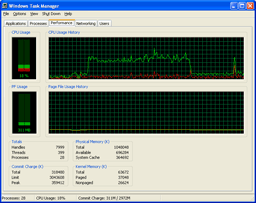 |
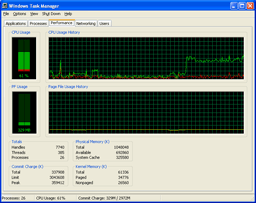 |
| Click to enlarge. | |
| MyHD | |
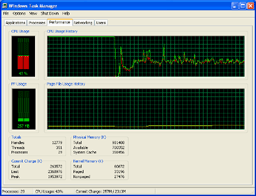
| 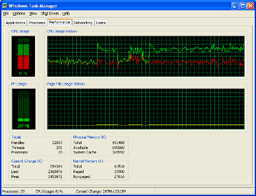 |
| Click to enlarge. | |
| Theater 550 | |
 |
 |
| Click to enlarge. | |
For watching analog content, not only is the Theater 550 a better image, but it also uses far less CPU power. In fact, the image for watching and recording with the Theater 550 is the same. Can you spot the point where we enabled recording in the graph? (The higher CPU usage at the start is actually PowerCinema loading, so don't confuse that with the latter portion of the chart.) We began recording the station on the 550 around the spot marked by the two "peaks" where CPU use spiked to 40% or so. Otherwise, CPU use remains around 10%.
The Fusion does quite well when only viewing analog channels, averaging around 20% CPU use on the Sempron system and slightly less (15%) on the 4000+ (which we didn't capture). Recording with the Fusion5 kicks CPU usage up to about 60%. That's a pretty big jump, but we were running with a maximized viewport (720p content), and we didn't experience any stalls or other problems. For watching an analog channel, the Fusion5 is a close second to the Theater 550, though it's a distant second for recording the content.
Finally, we have the MyHD card. Similar to the Fusion, watching an analog channel uses less CPU time than recording the channel. However, less in this case means about 40% CPU usage. Enabling even the fastest DivX encoding (with MP3 audio) kicks the CPU up to almost 80% usage. The video capture doesn't cut out, but there does seem to be a slight delay every second or so. Even though there is supposedly 20% idle CPU time, the capture isn't really clean, and it's about equal to watching TV with only mediocre reception. We don't have a graph, but moving to the 2.6 GHz X2 chip with Normal quality DivX encoding still used a whopping 65% of the CPU time - remember that there are two cores, so that would be over 130% CPU time for the 4000+. The faster X2 also removed the slight lag in the video, all while producing a much better encode.
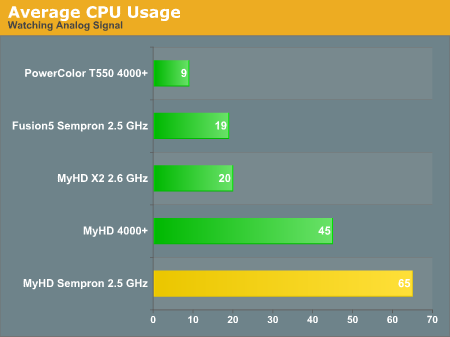
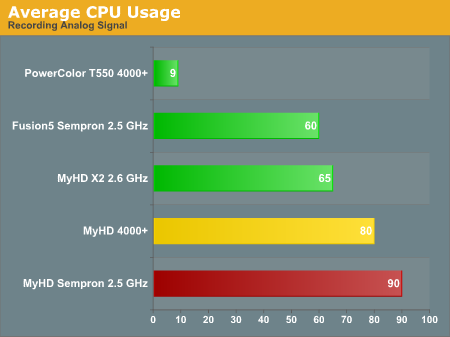
Here's another version of the data, with a few additional reference points. The graphs are colored according to performance: green indicates that there were no difficulties, yellow means that there may be periodic issues, and red means that the result was unacceptable.
Digital Channels (watching on left, recording on right)
| FusionHDTV DxVA | |
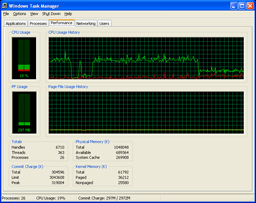 |
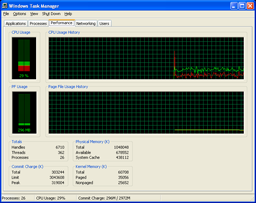 |
| Click to enlarge. | |
| FusionHDTV non-DxVA | |
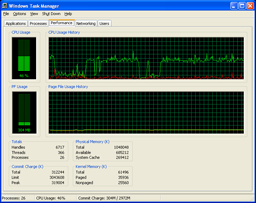 |
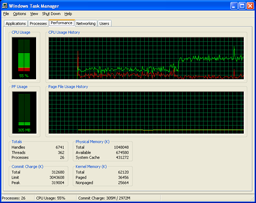 |
| Click to enlarge. | |
| MyHD | |
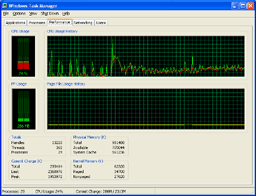 |
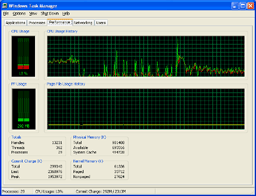 |
| Click to enlarge. | |
Moving to digital channels removes the Theater 550 from the list, but we have both the DxVA accelerated and non-DxVA modes in FusionHDTV. Most modern GPUs can use the DxVA acceleration, so consider the non-DxVA charts to be a worst case scenario. All of the results were taken while viewing a 1080i football game broadcast.
With DxVA enabled, watching 1080i with the Fusion5 requires about 20% of your CPU time. Recoding the same content appears to add about 10% more CPU use, and we get close to 30%. The non-DxVA mode requires quite a bit more power to handle the decoding of the digital signal, using 45% of the CPU power. As before, recording the same content appears to add another 10%. Remember that unlike analog signals, digital TV is already compressed. Decompressing is quite a bit easier than compressing a signal, which is why a Sempron can handle 1920x1080 video at 30 FPS without trouble, whereas the same CPU chokes when attempting to encode even 640x480 video at 30 FPS.
Viewing digital content with the MyHD is completely different from using the card in analog mode. CPU usage on the 4000+ was around 25% when viewing a 1080i signal, though disabling the overlay screen knocks that down around 15%. The record mode oddly enough has consistently lower CPU usage, at around 12 or 13%. The hardware acceleration of DTV decoding that the MyHD card provides is clearly put to good use.
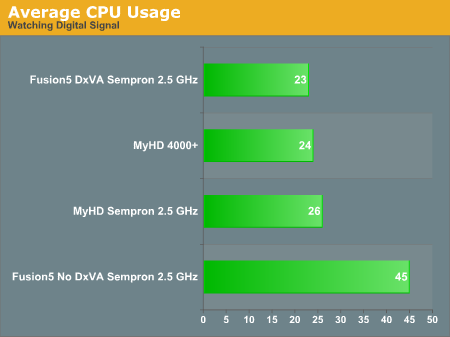
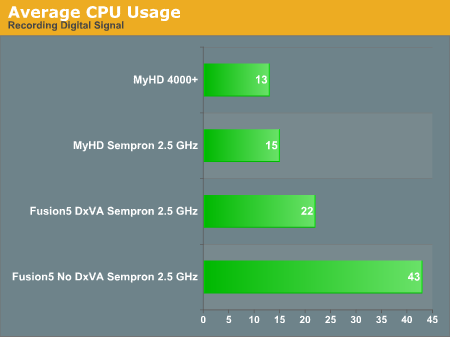
Again, here's the simplified graph. All of the results are green, as there were no difficulties. Judging by the CPU usage on the Sempron for the MyHD, most of the CPU usage is used by the overlay window.










77 Comments
View All Comments
JarredWalton - Wednesday, December 7, 2005 - link
Does DirectShow encoding plug into the VFW interface? (I think I've only used it for decoding, not encoding.) Same goes for AVI.NET - I haven't ever heard about that one, but then there's all sorts of stuff I've never heard of. :)xtknight - Thursday, December 8, 2005 - link
DirectShow doesn't necessarily use VfW. It's a separate interface for the most part, although you can still plug in VfW codecs in DirectShow filter graphs (basically flowcharts for video playback/capture/etc). You probably have only used it for decoding because there are not many DirectShow encoders.Homepage for AVI.NET: http://www.clonead.co.uk/">http://www.clonead.co.uk/
xtknight - Wednesday, December 7, 2005 - link
Realtime encoding can also be done by DirectShow, but I'm not aware of any apps that use it.sprockkets - Wednesday, December 7, 2005 - link
if it supports divx it supports xvid usually as well.Of course I could be wrong, but the way it works is they encode differently, but both can be decoded the same, right? Xvid can decode divx, so isn't like the same with mp3, different encoders but one decoder can do it all, since it is just mpeg-4?
segagenesis - Wednesday, December 7, 2005 - link
There is good reason for using Divx despite the fact xvid/ffdshow exist. Primarily from experience I should say taht xvid/ffdshow (with the latter of the two being particuarly bad) are slower than Divx as far as playback speed. This becomes more noticeable on slower computers, actually making a difference between full speed and jittery playback on some. If you have the CPU power, however, go for using xvid/ffdshow combination.bofkentucky - Wednesday, December 7, 2005 - link
Problem is, my cable boxes (Motorolla 6412, Dual tuner, DVR) can only output HD signals on the component, DVI, and HDMI ports, anyone know of a HDTV tuner card than has component or DVI in or a converter box that can take a component in coax out without mangling the signal?Griswold - Tuesday, December 13, 2005 - link
|-------| AFPL )
|-------
|
|
The Boston Dangler - Wednesday, December 7, 2005 - link
There is no such beast, nor will there be.gibhunter - Wednesday, December 7, 2005 - link
I too have the Moto 6412 Dual Tuner HD box. It is so good that it has kept me from actually building an HTPC. Now regarding your question, I don't think there is a way to do it. I do know from reading the www.avsforum.com that there is a driver for windows that will allow you to hook up a PC to the Moto DVR using the firewire connection. Then you can just copy the recordings straight from the DVR instead of re-recording them on the PC.Beenthere - Wednesday, December 7, 2005 - link
As in NO I have never considered using my PC as a home entertainment center. I guess some folks do but for me I'd prefer to build an "entertainment center" from commercial hardware components, not from add-ins to my PC.I could see a college student or someone with limited space combining their PC and movie viewing into one piece of hardware or maybe for viewing at work, but for the home, I don't see the advantage of using your PC for the basis of an entertainment center when it's not the best "tool for the job".